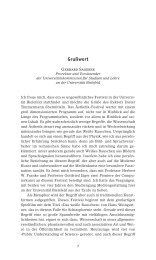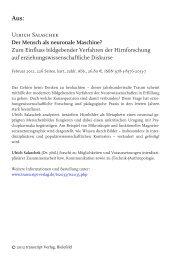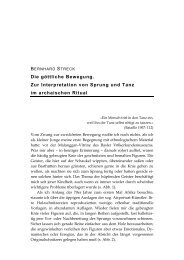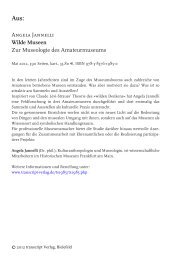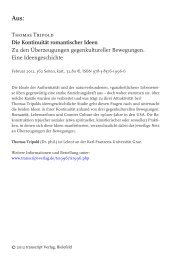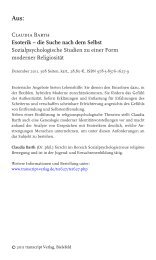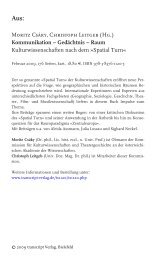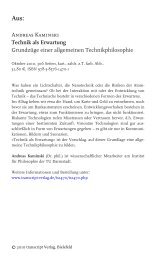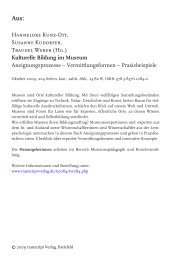Julia Straub (ed.) Paradoxes of Authenticity Studies on a Critical ...
Julia Straub (ed.) Paradoxes of Authenticity Studies on a Critical ...
Julia Straub (ed.) Paradoxes of Authenticity Studies on a Critical ...
You also want an ePaper? Increase the reach of your titles
YUMPU automatically turns print PDFs into web optimized ePapers that Google loves.
24 | JULIA STRAUB<br />
youths whose parents had immigrat<str<strong>on</strong>g>ed</str<strong>on</strong>g> to Britain in the mid-twentieth<br />
century. In order to pass as authentic, in this c<strong>on</strong>crete case this means<br />
falling into the more recent category <str<strong>on</strong>g>of</str<strong>on</strong>g> being authentically ‘BrAsian,’<br />
these individuals recur to codes and gestures embodying the ‘other’<br />
and serving as identity markers. They act according to stereotypes<br />
they believe make them appear ‘real’: by living up to them they authenticate<br />
their own hybrid cultural identity. BrAsian identity is upheld<br />
against white Britishness, but is ultimately defin<str<strong>on</strong>g>ed</str<strong>on</strong>g> by the latter,<br />
the touchst<strong>on</strong>e against which the authentic other is generat<str<strong>on</strong>g>ed</str<strong>on</strong>g>. Sabine<br />
Nunius’s c<strong>on</strong>tributi<strong>on</strong> gives an interesting case study <str<strong>on</strong>g>of</str<strong>on</strong>g> the performative<br />
dimensi<strong>on</strong> <str<strong>on</strong>g>of</str<strong>on</strong>g> authenticity, which also serves as a good example <str<strong>on</strong>g>of</str<strong>on</strong>g><br />
authenticity’s reacti<strong>on</strong>ary potential. Thus, authenticity is not <strong>on</strong>ly a<br />
feature, state or c<strong>on</strong>diti<strong>on</strong>, it is also reach<str<strong>on</strong>g>ed</str<strong>on</strong>g> by means <str<strong>on</strong>g>of</str<strong>on</strong>g> being full <str<strong>on</strong>g>of</str<strong>on</strong>g><br />
effects which are gear<str<strong>on</strong>g>ed</str<strong>on</strong>g> at an audience.<br />
<str<strong>on</strong>g>Authenticity</str<strong>on</strong>g> and Authorship<br />
<str<strong>on</strong>g>Authenticity</str<strong>on</strong>g> and authorship are in a vex<str<strong>on</strong>g>ed</str<strong>on</strong>g> relati<strong>on</strong>ship. As shown by<br />
their respective etymological roots, both terms single out authorizati<strong>on</strong><br />
as an important strand <str<strong>on</strong>g>of</str<strong>on</strong>g> meaning. Both terms have had a vari<str<strong>on</strong>g>ed</str<strong>on</strong>g> life<br />
in the twentieth century. Once declar<str<strong>on</strong>g>ed</str<strong>on</strong>g> dead, their vital signs remain<br />
hard to ignore (see Burke and D<strong>on</strong>ovan/Fjellestad/Lundn). However,<br />
authorship is usually understood as referring to the external or social<br />
pers<strong>on</strong>a <str<strong>on</strong>g>of</str<strong>on</strong>g> the author, and not so much to the ‘real’ pers<strong>on</strong> behind the<br />
name <strong>on</strong> the book cover. Authors <str<strong>on</strong>g>of</str<strong>on</strong>g>ten struggle to c<strong>on</strong>trol their public<br />
image: impers<strong>on</strong>ality and c<strong>on</strong>spicuousness are the two main facets <str<strong>on</strong>g>of</str<strong>on</strong>g><br />
embodi<str<strong>on</strong>g>ed</str<strong>on</strong>g> authorship, as seen in J.M. Coetzee and Philip Roth, for example.<br />
The ways in which actors, musicians and, to a lesser degree,<br />
artists are rever<str<strong>on</strong>g>ed</str<strong>on</strong>g> in today’s culture, and the ways in which their c<strong>on</strong>formity<br />
to pre-fabricat<str<strong>on</strong>g>ed</str<strong>on</strong>g> ideas <str<strong>on</strong>g>of</str<strong>on</strong>g> their public pers<strong>on</strong>a comes to count<br />
as authentic are well-known. To say similar things about authors –<br />
who <str<strong>on</strong>g>of</str<strong>on</strong>g>ten shun the public gaze and step back behind their work as<br />
nameless entities – seems unusual still, but the noti<strong>on</strong> <str<strong>on</strong>g>of</str<strong>on</strong>g> star authors<br />
has reach<str<strong>on</strong>g>ed</str<strong>on</strong>g> discourses <strong>on</strong> c<strong>on</strong>temporary authorship (see Moran). Literary<br />
stardom, coupl<str<strong>on</strong>g>ed</str<strong>on</strong>g> with the noti<strong>on</strong> <str<strong>on</strong>g>of</str<strong>on</strong>g> the author as a brand or label<br />
who inhabits a globaliz<str<strong>on</strong>g>ed</str<strong>on</strong>g> marketplace – these are all phenomena<br />
that have caught our attenti<strong>on</strong> over the last ten years. A good example



